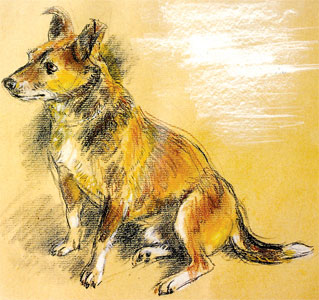|
Learn to draw by Tissa Hewavitarane:
Working with pastels
Pastels are a vastly underrated medium and I wish they were given
more credit. They have a lot to offer in terms of freshness of colour
and work well with other media. The origin of the pastel technique go
back in time. It can be traced back to the caveman.
|

A pastel drawing done of a dog |
This is obtained from red earth which was ground into powder and then
mixed with water to produce a paste which was then shaped into sticks
and dried in the sun.
The real birth of drawing with pastels came at the end of the Middle
Ages when people began to prepare sticks of different colours to use in
finishing or touching up frescoes.
The most popular surface on which to work with pastels is slightly
rough drawing paper, since it holds the colour better than smooth paper.
White or coloured papers may be used. If coloured paper is used, the
background helps to blend the colours and to produce certain effects
quickly and easily. Dark coloured papers may also be used, in which case
lighter values of pastels are employed to bring out the form and the
highlights.
Pastels are the simplest and most direct way of painting because you
do not need a palette or brushes. It is difficult to obtain precise
blends of colour. It is best to have a large number of pastels available
to get any colour you need to finish your drawing. Some artists use the
fingers to blend the colours.
If you do not want to use your fingers, you will need to keep handy
little strips of white paper or cloth as well as clean rags. These can
be used delicately to obtain blending of colours which would otherwise
be impossible. Always remember that shading should be used sparingly,
that is only when and where the subject really calls for it. One way to
get good results more easily is to work on a larger scale than the
subject.
Always keep a selection of hard pastels at hand. These can be
sharpened and will help you to define the finest details better. This is
of particular benefit when you need to do a portrait or figure work.
With pastels it is usually possible to rub out what you have done and
start again. This can be done at any stage of the work, simply by
rubbing the drawing with a dry sheet of paper or soft rag.
Almost all the colours will be removed in this way. Pastel sticks are
well worth to do a portrait particularly those where you want details
rather than broad effects. |

